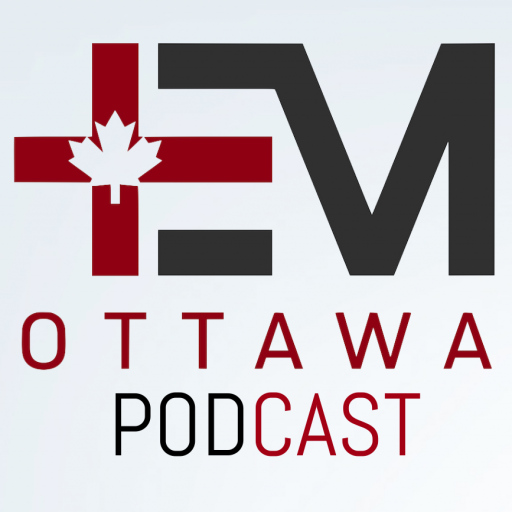Dr. Rajiv Thavanathan sits down with Dr. Jim Yang to talk about some of the best high impact trials in the last year in Emergency Medicine. Which patients with a GI bleed need urgent endoscopy, and which patients ACTUALLY need targeted temperature management (TTM) after cardiac arrest.
Acute Upper GI Bleeds– Does timing matter?
Timing of Endoscopy for Acute Upper Gastrointestinal Bleeding
Design
- Single centre, RCT performed in Hong Kong
- 516 patients
- Patients with overt UGIB, specifically with hematemesis or melena, with a Glasgow Blatchford Score (GBS) of >12
Rapid GBS Review
- GBS > 1 suggests at risk for needing intervention
- GBS > 6 traditionally predicted the need for intervention
- GBS > 12 associated with increased mortality
Intervention
Compared urgent endoscopy (endoscopy performed within 6-hours of GI consult) to early endoscopy (endoscopy performed within 6-24 hours of GI consult). Practically, speaking this means that people in the urgent endoscopy group were scoped overnight if they came in the evening.
All patients received standardized care, consisting of a high-dose PPI, and if concerns for variceal bleeding, vasoactive medications (i.e. octreotide) and antibiotics for spontaneous bacterial peritonitis (SBP) prophylaxis.
Exclusion Criteria
- Patients with hypotensive stock who failed to stabilize after initial resuscitation or patients moribund from terminal illness.
Endoscopic Findings
- Peptic ulcer disease (PUD) ~60%
- Variceal bleeding (7-9% of study)
Note: Epidemiologically, PUD is seen at much higher rates in Asian populations, so this prevalence was expected.
Outcomes
No difference in all-cause mortality at thirty-days.
No difference in further bleeding, the amount of blood transfusions, the rates of surgery or embolization, or hospital or ICU length of stay.
Urgent endoscopy is more technically challenging. Waiting gives the medications more times to act, which improves visibility, resulting in less and more-targeted interventions.
Limitations
Given the study’s low prevalence of variceal bleeds, we can’t apply this to variceal bleeds, a known higher-risk population. This study also excluded patients in shock, so clinical judgement and early involvement of endoscopists is still warranted in these very sick patients.
Additionally, this only applies to larger centers where you have quick access to endoscopists. Particularly in the community, it’s prudent to still discuss these cases with gastroenterology early, as we know these patients can quickly decompensate.
Case application
60 y/o M, known PUD, CC’ melena & presyncope.
Vitals: HR = 115, BP = 90/60 mmHg
Labs: Hgb = 52 g/L
As per our trial, this is indeed a patient who could be delayed until the next morning for early endoscopy. However, if that patients develops any hemodynamic instability, or signs of ongoing bleeding, Dr. Jim Yang would advocate for an earlier endoscopy.
Therapeutic Hypothermia after ROSC
Is therapeutic hypothermia post ROSC always a good thing?
Or does this depend on the underlying etiology (cardiac vs non-cardiac) and the pre-post ECG rhythm? What temperature should we aim for?
Pathophysiology Summary:
Anoxic brain injury is associated with increased mortality and morbidity. Fevers are bad and can worsen ischemic brain injury. The theory behind therapeutic hypothermia is that it reduces free radicals, cerebral oxygen consumption, and ultimately reduces ischemic injury.
The initial trials (early 2000s) were small RCTs showing a huge difference in favorable neurologic outcomes for hypothermia post shockable rhythms (post VF and pVT arrest).
But in 2013 the TTM trial was published: Targeted Temperature Management at 33°C versus 36°C after Cardiac Arrest
The TTM Trial by Nielsen et al. (2013) was a large RCT of 939 patients. It showed that unconscious survivors of out-of-hospital (OOH) cardiac arrest, of presumed cardiac cause (but of all rhythms, shockable and non-shockable) there were no difference in outcomes between a temperature target of 33° C vs. 36° C.
Flash-forward to the HYPERION Trial this past year: Therapeutic Hypothermia After Cardiac Arrest With Non-Shockable Rhythm
Design
- Multi-center, RCT performed in 25 ICUs in France
- 581 adult patients
Included
- ROSC following in hospital (IH) or out of hospital (OOH) cardiac arrest with non-shockable rhythm due to any cause
- Patients had to be comatose post (GCS <8)
Excluded
- Patients with poor prognostic indicators.
- More than 10-minutes from collapse to initiation of CPR.
- More than 60-minutes from initiation of CPR to ROSC
- Those in refractory shock despite vasopressors
Intervention
- Randomized to either period of hypothermia (targeted temp 33°) vs normothermia (targeted temp 37°)
- Hypothermia group was cooled after randomization and maintained at 33° for 24-hours, then slowly rewarmed with fever avoided over the subsequent 24-hours.
- Normothermia group cooled if need (avoidance of fever) for up to 48-hours
Outcomes
- Primary outcome: Survival with favorable neurologic outcome
- Secondary outcomes: mortality, length of mechanical ventilation, length of ICU stay, adverse events
Results
Hypothermia was associated with improved survival with favourable neurologic outcome. 10% in hypothermia group vs. 6% in normothermia group. However: No difference in overall mortality, no difference in duration of mechanical ventilation, ICU length of stay, or adverse events.
Note: hypothermia group had TTM for a longer duration than the normothermia group.
The normothermia had avoidance of fever for 48-hours, whereas the hypothermia group had induction of hypothermia & maintenance for 24 hours, a period of rewarming, and then maintenance of rewarming for an additional 24 hours. In total, between 56-64 hours of TTM.
Also, a substantial number of patients in the normothermic group were not normothermic! Although target was 37° C, Patients randomized to this group developed fevers > 38° C throughout the TTM period.
Bottom Line
- Fever is bad.
- All patients who are comatose following ROSC should be cooled to prevent fever.
- Temperature you end up at isn’t as important as long as you avoid fever.
For Dr. Jim Yang, the next patient he sees post ROSC, regardless of shockable vs non-shockable rhythm, he’ll be targeting a temperature of 32-36^C, keeping with the American Heart Association and European Resuscitation Counsel.
We should be initiating cooling for all ROSC patients in the ED.
This can be as simply as
- Inserting a bladder temperature probe
- Placing ice packs on the patients groin and axilla
Any regarding rates of adverse events?
There has never been any document increase in rates of adverse events between hypothermia and normothermia in ANY of published RCT to-date.
Show notes compiled by Dr. James Gilbertson
Original music by Eusang



